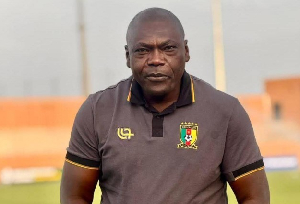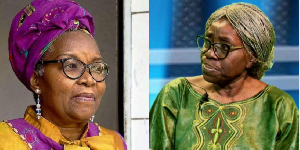By presidential decree, retired striker Roger Milla was included in Indomitable Lions’ 1990 World Cup team. Many squad members were not happy but the ageing striker went on to have a storming tournament that ended at the quarters stage.
Every once in a while, you are forced to clear your throat and take a deep breath before admitting that African dictators, including the most bloodthirsty ones, do get their sporting instincts right and in so doing transform the destinies of many people.
This series begun with an account of how the Zairean kleptomaniac, Mobutu Sese Seko, used football to put the country he was looting on the world map. Before 2012, the mention of a place called Equatorial Guinea would have elicited a raise of quizzical eyebrows anywhere but in that dirt poor oil-rich country.
But Teodoro Obiang Nguema Mbasogo, Equatorial Guinea’s brutal ruler for the last 35 years, co-hosted the 2012 Africa Nations Cup with neighbouring Gabon and now you will never talk of Zambia’s unforgettable victory without mentioning Equatorial Guinea.
DODGY CLAIMS Kenya, a country with a high world profile for both good and bad reasons, has only made dodgy claims about bringing Africa’s premier football showcase here. Obiang, for that is how he is universally known, gained power by ousting his suspected insane uncle in a military coup, putting him through a speedy trial and then having him executed by firing squad.
The less we talk about the “the country’s god who has power over men and things and is in permanent contact with the Almighty and can decide to kill without anyone calling him to account and without going to hell” according to his State Radio, the better.
Under Field Marshall Idi Amin Dada, Uganda missed winning the 1978 Nations Cup by a whisker. It was then a continental football powerhouse. Today, just qualifying for the final rounds of that tournament could very well spark a national holiday. But let’s also not talk about Idi Amin.
A “request” made by President Paul Biya of Cameroon before the 1990 World Cup forever changed the way the world views African football. It led to the emergence of a world superstar who scored brilliantly taken goals and revolutionized the art of celebrating them.
AGE JUST A NUMBER Against men young enough to be his sons, this 38-year-old man proved that age is but a mere number. The performance of his team forced Fifa to take away one slot from Europe and give it to Africa in future World Cups. In a word, Biya’s “request” re-wrote the record books.
Biya is the man who has ruled Cameroon for the last 32 years. A permanent fixture in any list of living tyrants in the world, Biya is noted for extended stays away from his country, always described as “short stays” by Cameroon’s official media.
He spends the time in luxurious Swiss hotels. Some stays are as short as two weeks but other short stays can go for up to three months. Enough about Biya. Before the 1990 World Cup, Biya noted the shambolic way in which Cameroon were preparing for their Italy outing. It was vintage Fecafoot – Cameroon Football Federation: player revolts over unpaid bonuses, corrupt officials salting away the cash, unpaid technical staff – all in the midst of a reputation of being the premier football nation in the continent when it came to actually kicking the ball.
First Biya recruited a Russian coach, a gentleman known as Valeri Nepomniachi, who spoke neither French nor English, Cameroon’s official languages. He communicated with the players through a translator who had been employed as a driver in the Cameroon Embassy in Moscow. The players just gritted their teeth.
PLAYERS HOSTILE Then Biya put through a request to Fecafoot, as if it was. Who was going to say “No”? He wanted Roger Milla, the greatest Cameroon striker of all time who was already three years into retirement, back in the team. Players were hostile to the idea – really an order – but what to do? Milla was back in the shirt of the Indomitable Lions.
Like Mobutu before him, President Biya was micromanaging his national team. And it paid off handsomely. But in all fairness, this was not unique to him. After Cameroon defeated defending champions Argentina in one of the great shocks of World Cup history in their opening game in Italy, Carlos Bilardo, Argentina’s manager, received calls from President Carlos Menem and his immediate predecessor, Raúl Alfonsín. Both gave him suggestions on the tactical changes to make for the next game.
“It was the worst moment of my sporting career,” Bilardo said. “Everyone called me to tell me what to do. I heard from the president, two former presidents and the opposition leader. I have never seen anything like it before in my life. I have never seen anything unify the nation like that. Not politics or music or anything. Everyone was watching and hoping for the team. And when we came home, they were happy for us. We were proud to have reached the final.”
But I am getting ahead of the story. Milla was back with Cameroon. Hopes and Dreams the official Caf book marking the 2010 World Cup in South Africa, noted the event thus: “Has there ever been a footballer more synonymous with a World Cup than Roger Milla is with Italia ’90?"
Forever an African football icon, Milla will always be remembered for the gladiatorial performances that propelled Cameroon into the quarter-finals of the World Cup, the first time ever an African team had gone that far.
“Seldom can the career of a footballer have been shaped so totally by a presidential act; Milla went on to become one of the heroes of the tournament, scoring four goals as Cameroon broke new ground for African football. To the delight of the watching world, he celebrated each of his goals with a jiggle and a wiggle at the corner flag. Full of running and energy but with neat skills and a definite eye for goal, Milla wrote his name into the record books four years later when he became the oldest player to ever score in a World Cup finals at 42.”
Cameroon lined up against Argentina in Italia ‘90s opening game. Few gave them a chance. François Omam-Biyik, the skilled forward who would become their goal scoring hero, said after the Cup holders were felled 1-0: “No one thought we could do anything here against Maradona, but we knew what we could do. We hate it when European reporters ask us if we eat monkeys and whether we have a witch doctor. We are real football players and we proved this tonight.”
The Western media made much out of Cameroon’s man to man marking tactics whose body contacts resulted in the dismissal of François’s brother, Andre Kana Biyik, and Benjamin Massing, making Cameroon finish the game with nine men. The reports were full of exaggerations that even the supposed victims sometimes refuted.
Pete Davies in his book, “All Played Out”, described Massing’s tackle on Claudio Caniggia as “a kind of full-pelt, waist-high, horizontal flying body check. The general intention seemed to be not so much to break Caniggia’s legs, as actually to separate them from the rest of his body.”
And Mathew Engel, writing for the UK’s Guardian, made this wild claim: “Cameroon neutralized Maradona mainly by kicking him. He spent much of the game horizontal despite wearing calf pads as well as shin pads. His 10 team-mates seemed too stunned to make any trouble but they were kicked as well, if they got in the way.”
Maradona himself disputed the claim. He said: “I don’t think they had any intentions of beating us up to win the game. I cannot argue, and I cannot make excuses. If Cameroon won, it was because they were the best side.” The truth of the matter is that Fifa had ordered referees of the tournament to get tough with defenders. Maradona was a phenomenon and he largely had to do with Fifa’s edict that genius must be allowed to flow and a second yellow card automatically meant a send-off.
Even Cameroon’s severest critics and Fifa officials agreed that the challenge that resulted in Andre Kana Biyik’s dismissal did not merit a red card; it’s just that he had been yellow-carded before and the new rule had to be applied.
Watching one of Cameroon’s games on television and listening to the commentary, one ecstatic fan beside me exclaimed: “I just love the sound of these African names - Onana! Kunde! Ekeke! Ebwelle! Omam-Biyick! Tataw! Makanaky! Milla!”
Apparently, he was not the only one driven to new highs of ecstasy by the fluency of Cameroon’s play and their enchanting ball control. Pepe Kalle, the Congolese musician, was inspired to compose a soaring song for the Cameroonians titled Roger Milla. Twenty four years later, the hit is just as engrossing.
The game between Argentina and Cameroon was played in the city of Milan. It so happened that Diego Maradona had just helped his club Napoli to a title triumph against eternal rivals Milan in the Italian league for the 1989-90 season.
Milan fans responded by wildly cheering Cameroon throughout the match. Maradona took it all in his stride, remarking that he had finally cured Italians of racism. He quipped: “The whole stadium was shouting for Cameroon,” he observed. “Wasn’t that nice?”
Cameroon epic run was brought to a halt by England in a game that exposed their inexperience at the big stage. England came from behind to beat them 3-2 when it looked their might be headed for semi-final showdown with the Argentina again.
Leading 2-1, they were toying around with England sometimes even within their own penalty area. But they failed to hold their advantage and England equalised before a Gary Lineker penalty put an end to a run that captured the world’s attention and imagination.
But nobody put it better than Roger Milla about what could possibly have happened if the team had progressed. Many people would have died. After losing to England, Milla told France Football: “I’ll tell you something. If we had beaten England, Africa would have exploded. Ex-plo-ded. There would have been deaths. The Good Lord knows what he does. Me, I thank him for stopping us in the quarter-finals.”
Cameroon returned home to rapturous welcome. Omam-Biyik remembered: “When we arrived at Douala airport, the aeroplane had to pull up and come around again because the runway was totally flooded with people.” The country enjoyed two days of a national party.
Their feat has since been replicated by Senegal and Ghana. No African team has broken the semi-final barrier. The reason is obvious: after Cameroon’s run in 1990, the world lost its innocence about African football.
The trickle of African players in Europe became a flood and previous backwater countries like Togo and Mali entered the world stage on account of the exploits of their stars plying their trade in Europe.
The secret was out – African football was world class. And Milla put it best: “No team could ever again do what we did in 1990. The element of surprise is not there. Everybody knows everything about all the teams now.”
Opinions of Sunday, 23 November 2014
Auteur: Roy Gachuhi














